Picture this: It’s a blazing 95°F afternoon, and you’re watching your chickens panting under the shade of their coop, wings spread wide and beaks open, clearly struggling with the heat.
Your crystal-clear swimming pool sparkles invitingly just a few yards away. You’ve seen those adorable YouTube videos of chickens floating like feathered pool toys, and suddenly you’re wondering – could a quick dip actually help your overheated flock?
I faced this exact dilemma three summers ago when my Rhode Island Red, Henrietta, looked like she was about to keel over from heat exhaustion.
My neighbor’s ducks were happily paddling in their pond while my chickens suffered in the shade. That day sparked my deep dive into understanding the complex relationship between chickens and water – and what I discovered might surprise you.
The Truth About Chickens and Swimming
Here’s what most people don’t expect to hear: chickens can indeed swim. But before you start shopping for tiny life jackets, understand that chicken swimming is like watching someone try to swim while wearing a heavy winter coat – technically possible, but definitely not their strong suit.
The reality is that chickens possess basic survival swimming abilities, but they’re about as comfortable in water as most cats. Swimming, for chickens, is an emergency skill rather than a leisure activity.
The Tale of Two Birds: Why Ducks Rule the Water While Chickens Rule the Land
To truly understand why your chickens eye water with suspicion, let’s examine the fundamental differences between chickens and their aquatic cousins.
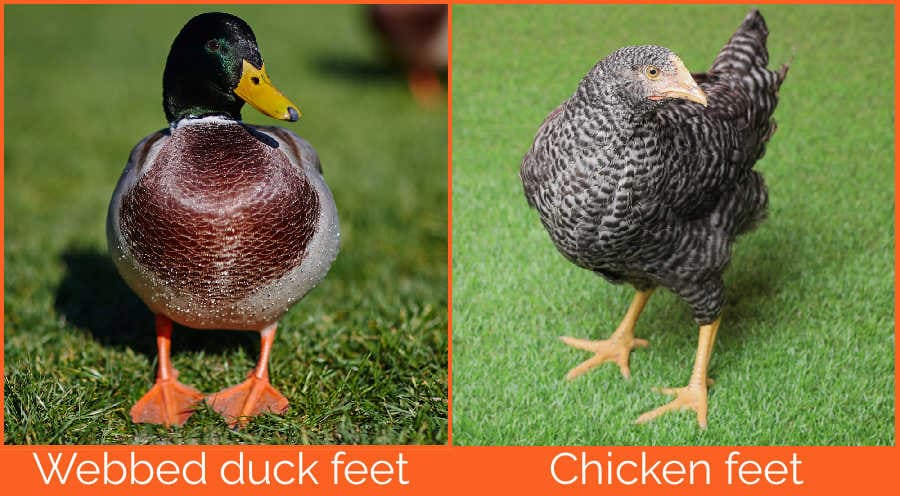
Ducks: Nature’s Swimming Champions
Ducks came equipped with premium water gear from the factory. Their webbed feet function like built-in swim fins, propelling them through water with remarkable efficiency.
More importantly, ducks possess a supercharged preen gland near their tail that produces copious amounts of waterproofing oil. Every time you see a duck methodically running its bill through its feathers, it’s essentially applying nature’s most effective waterproof coating.
This oil creates an impenetrable barrier that causes water to bead up and roll right off – you’ve literally seen water roll off a duck’s back. Their feathers also have specialized microscopic hooks called barbules that lock together, creating air pockets that provide exceptional buoyancy.
Read about Mixing Birds in Your Backyard: Can Chickens and Ducks Live Together?
Chickens: The Land-Based Specialists
Chickens evolved in forested environments where their talents lay in scratching through leaf litter, not navigating waterways. Their feet feature separate, clawed toes designed for digging and gripping – perfect for finding bugs and maintaining balance on uneven ground, but offering minimal propulsion in water.
While chickens do have preen glands, they’re considerably smaller and produce only about 10% of the oil that ducks generate. Their feathers lack the sophisticated interlocking system that makes waterfowl so buoyant.
Think of chicken feathers as water-resistant rather than waterproof – they’ll handle light rain just fine, but prolonged water exposure will eventually soak through.
What Actually Happens When Chickens Enter Water
Understanding the swimming process helps explain why it’s generally not recommended for chickens.
The Initial Float Phase
When a chicken first enters water, you might be impressed by their apparent competence. Most chickens will instinctively level their bodies, hold their heads high, and begin paddling with a motion surprisingly similar to ducks. Their feathers initially trap enough air to keep them buoyant, and many chickens can float quite peacefully for the first few minutes.
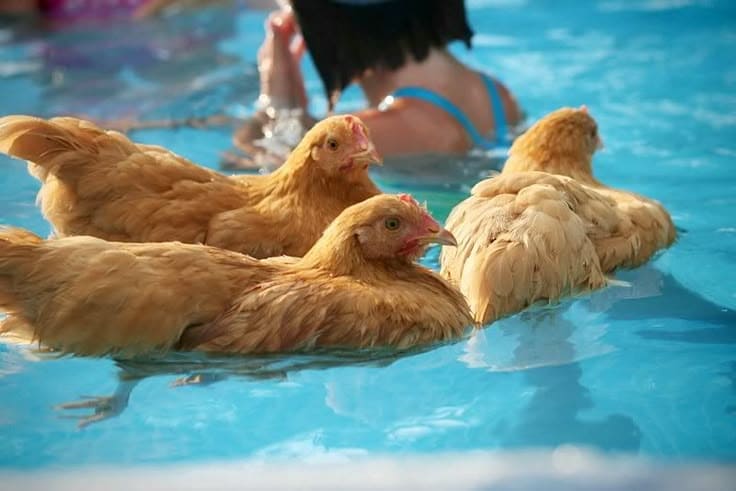
The Critical Waterlog Timeline
Here’s where things get serious. Unlike ducks, whose feathers actively repel water, chicken feathers gradually absorb moisture. The timeline varies depending on several factors:
- Water temperature plays a crucial role – cold water accelerates the soaking process and increases the risk of hypothermia. Warm water (around 85°F) is much safer if you absolutely must let a chicken swim.
- The chicken’s temperament dramatically affects survival time. A calm, relaxed chicken might float comfortably for 10-15 minutes. However, a panicked bird thrashing around can become waterlogged and sink in under 60 seconds.
- Feather condition matters too. Chickens with tight, well-maintained feathers resist water longer than those with loose or damaged plumage.
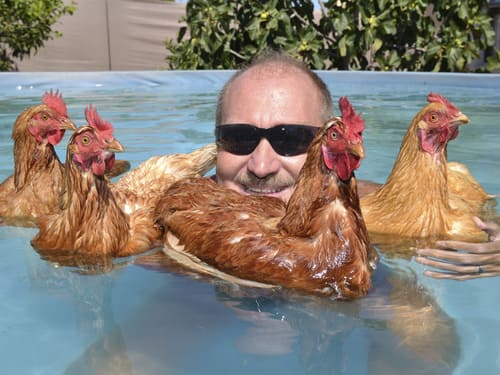
When Panic Sets In
Most chickens experience some level of stress when placed in deep water. This isn’t surprising – imagine being dropped into an environment where you can’t touch bottom and everything feels foreign. Stressed chickens often:
- Flap frantically, which accelerates water absorption
- Struggle to keep their heads up, risking water inhalation
- Exhaust themselves quickly through inefficient movements
- Lose their natural buoyancy through aggressive splashing

The Baby Chick Exception: A Non-Negotiable Safety Rule
If you take away just one piece of information from this article, let it be this: baby chicks and water simply don’t mix. This isn’t a recommendation – it’s a critical safety rule that can mean the difference between life and death for young birds.
Baby chicks don’t have proper feathers; they’re covered in fluffy down that acts like a natural sponge. The moment this down contacts water, it absorbs liquid instantly, pulling the chick underwater with surprising speed.
Even more dangerous, wet chicks lose body heat rapidly and can die from hypothermia within minutes, even in seemingly warm conditions.
I’ve heard tragic stories from well-meaning chicken keepers who thought a shallow dish of water would help their chicks cool off on a hot day, only to find drowned babies later. Until your chicks develop their first set of real juvenile feathers (usually around 6-8 weeks), keep them away from any water deeper than what they need for drinking.
Read the Ultimate Guide to Welcoming Baby Chicks: Setup, Care, and Tips for First-Timers
Debunking Common Swimming Pool Myths
Those viral videos of chickens peacefully floating in swimming pools have created some dangerous misconceptions. Let’s address the reality behind these seemingly harmless scenes.
The Chemical Cocktail Problem
Swimming pools aren’t just water – they’re complex chemical environments designed to kill bacteria, prevent algae growth, and maintain water clarity. The typical pool contains chlorine, stabilizers, pH adjusters, algaecides, and clarifiers. While these chemicals are generally safe for humans in small doses, we have no research on their effects on chickens.
Chickens will inevitably drink pool water while swimming, and their smaller body size means they’re more susceptible to chemical toxicity. Additionally, these chemicals can strip away the natural oils that provide what little water resistance chicken feathers possess.
The Escape Route Reality
Standard swimming pools present a death trap for chickens due to their smooth, vertical walls. Unlike ponds or streams with gradually sloping banks, pools offer no natural exit points. A tired chicken has no way to climb out, turning what might start as a pleasant float into a drowning situation.
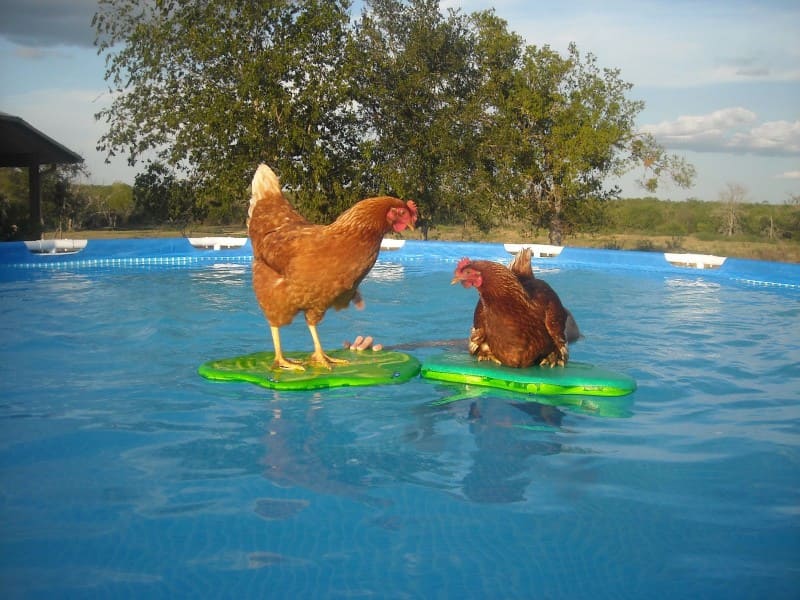
The Hygiene Factor
Let’s address the elephant in the room – chickens aren’t housetrained. They’ll defecate in pools, potentially introducing harmful bacteria like salmonella into water where humans swim. This creates health risks for both your family and the chickens themselves.
Heat Stress: Understanding Why Water Seems Appealing
Since overheating often triggers thoughts of chicken swimming, it’s important to recognize heat stress symptoms and understand better cooling alternatives.
Recognizing Heat Exhaustion in Chickens
Chickens begin showing heat stress when temperatures climb above 85°F, especially with high humidity. Watch for these warning signs:
- Panting with open beaks and extended necks
- Wings held away from their bodies
- Lethargy or reluctance to move
- Pale combs and wattles
- Reduced egg production
- Seeking the coolest available spots
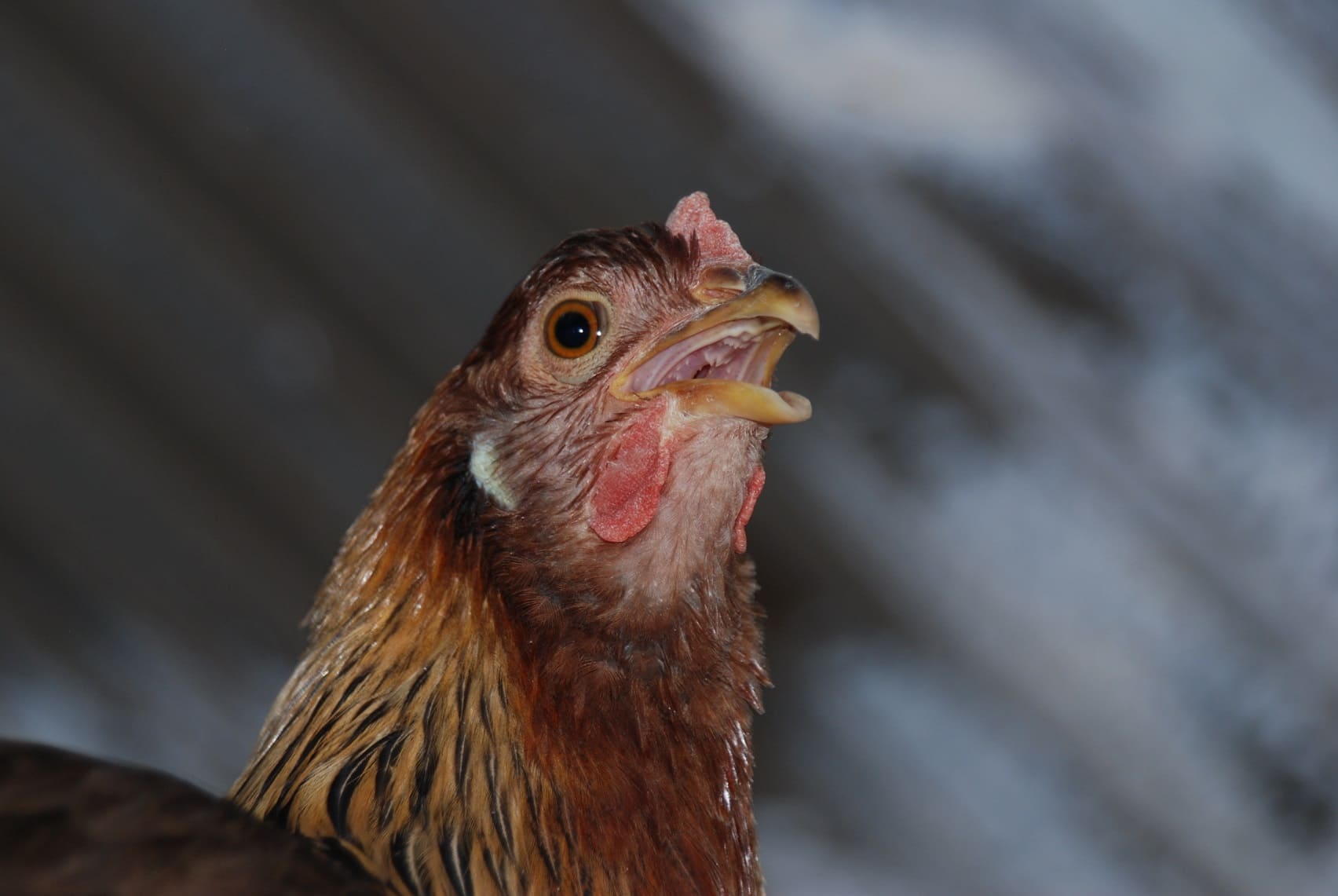
Why Chickens Choose Dust Over Water
Understanding chicken biology helps explain their bathing preferences. In nature, chickens take elaborate dust baths by digging shallow depressions in dry earth and vigorously fluffing dirt through their feathers. This behavior serves multiple purposes:
- Parasite control ranks as the primary benefit. The fine particles irritate and suffocate external parasites like mites and lice, while the physical action helps dislodge them.
- Temperature regulation happens as the dust absorbs excess oils and moisture, helping chickens maintain optimal body temperature.
- Social bonding occurs when chickens dust bathe together, reinforcing flock relationships.
- Stress relief appears to be another benefit, as chickens often seem more relaxed after thorough dust bath sessions.
This natural behavior explains why chickens prefer dusty, dry environments over water for their personal hygiene needs.
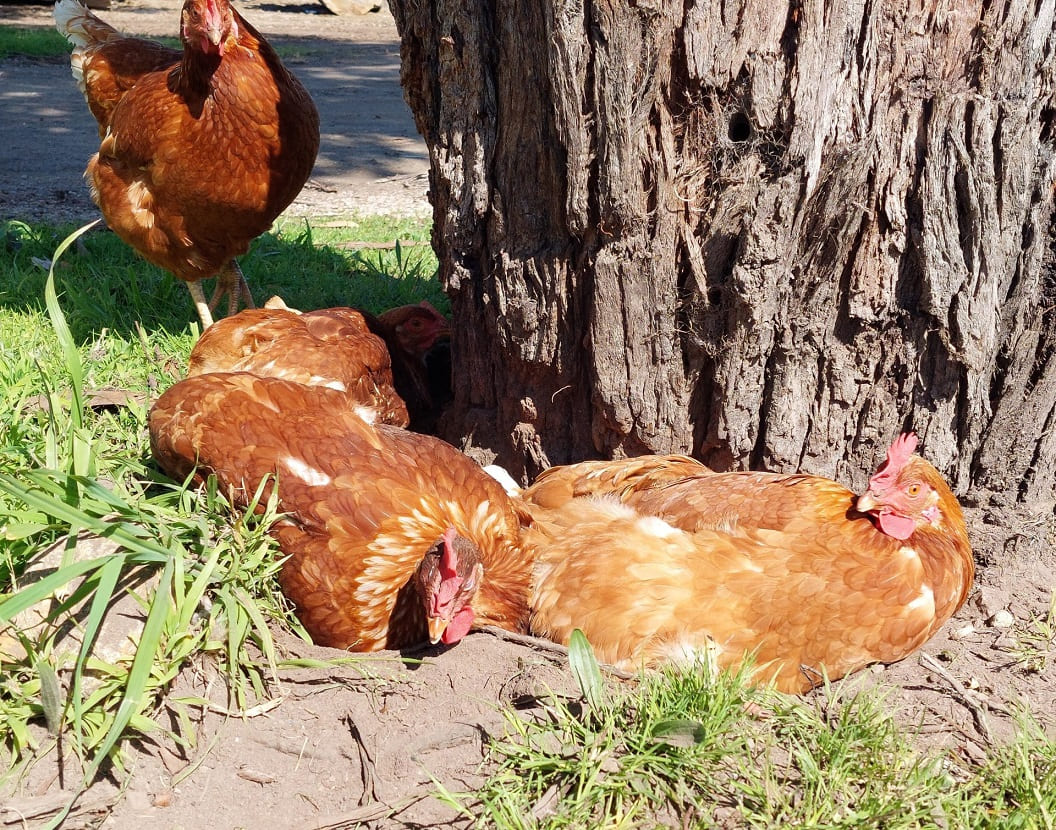
Safe Cooling Alternatives That Actually Work
Rather than risking water-based cooling, try these proven methods for keeping chickens comfortable during hot weather.
The Shallow Wading Solution
A children’s kiddie pool filled with just 2-3 inches of fresh, cool water can provide relief without swimming risks. The key is keeping water shallow enough that chickens can comfortably stand with their heads well above water level. Place some flat stones or bricks in the pool to give chickens stable footing and easy exit points.
Many chickens enjoy standing in cool, shallow water to lower their body temperature through their feet, which are excellent heat exchangers. This gives them control over their cooling without the dangers of deep water swimming.
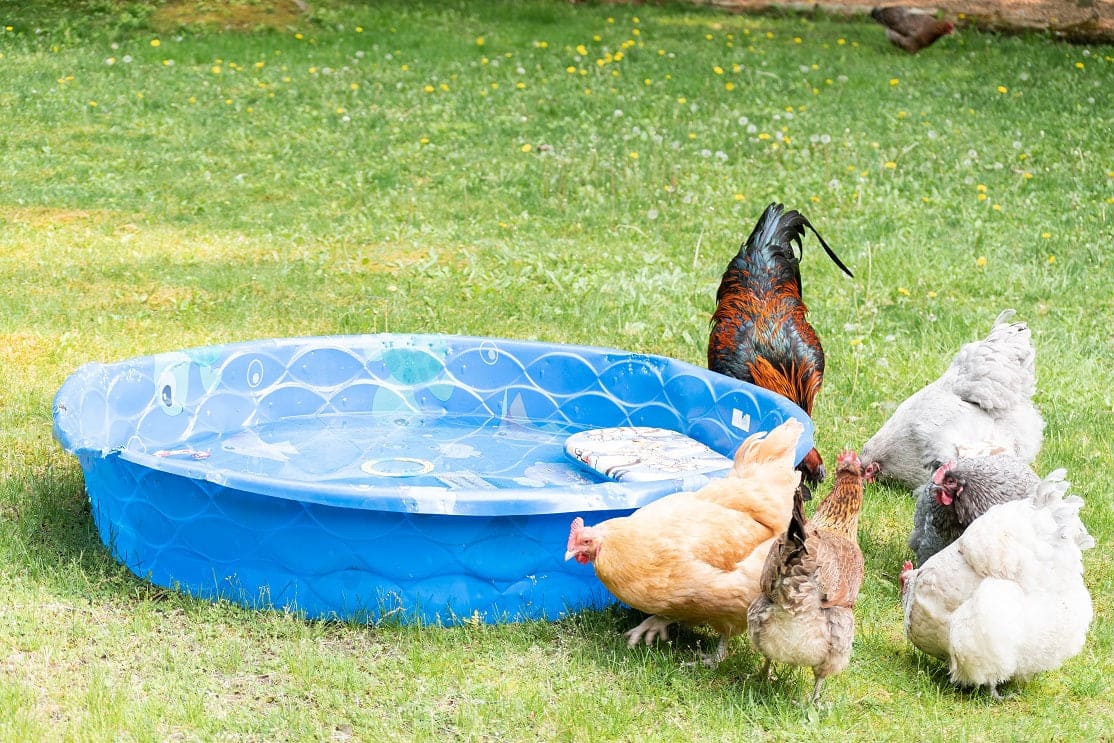
Strategic Shade and Airflow
Proper ventilation often matters more than water access. Ensure your coop has adequate airflow without creating drafts that could harm chickens in winter. Consider installing fans for the hottest days, positioning them to create gentle air movement rather than direct blasts.

Shade management makes an enormous difference. Natural shade from trees is ideal, but shade cloth, tarps, or temporary structures can provide relief. Remember that shade needs change throughout the day as the sun moves.
Learn more about Winter Care for Chickens: Tips to Keep Your Flock Healthy and Happy
Frozen Treat Solutions
Chickens love frozen treats that provide both cooling and entertainment. Try freezing fruits like watermelon, berries, or chopped vegetables in ice blocks. Hanging frozen corn on the cob gives chickens something cool to peck while encouraging natural foraging behaviors.
Creating “chicken popsicles” by freezing treats in muffin tins or ice cube trays provides portion-controlled cooling that won’t upset their digestive systems.
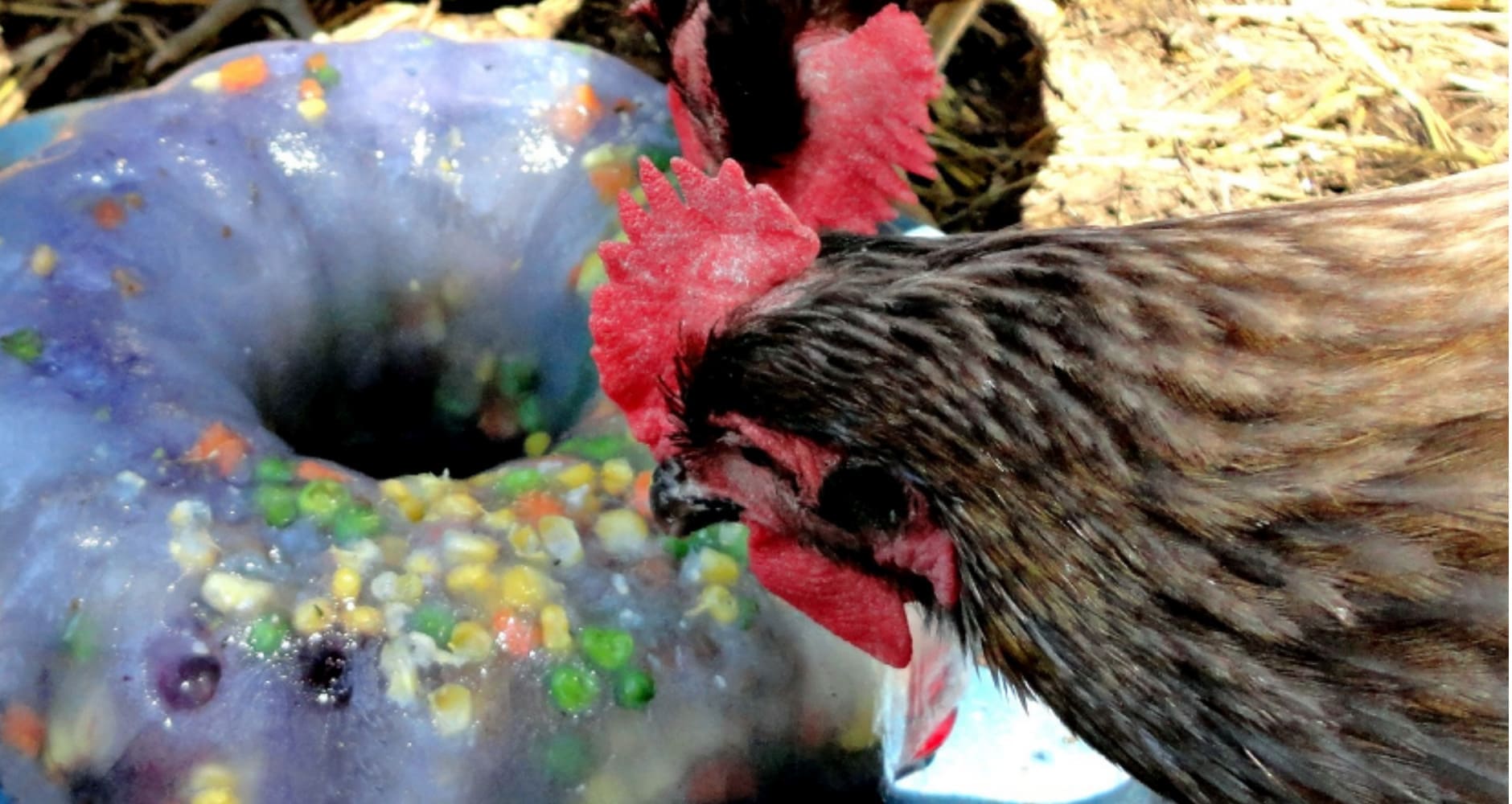
Misting and Sprinkler Systems
Gentle misting systems allow chickens to choose their level of water contact. Many birds enjoy walking through light sprinkler spray on extremely hot days, getting just damp enough to cool down without becoming soaked.
The key is providing options rather than forcing water contact. Some chickens will embrace the mist while others prefer to stay dry and find cooling through other methods.
Emergency Response: When Things Go Wrong
Despite your best efforts, accidents happen. Knowing how to respond can save your chicken’s life.
Immediate Rescue Protocol
If you find a chicken in distress in water, act quickly but calmly. Scoop the bird up gently, supporting its body to avoid injury. Chickens in water emergencies are often panicked and may struggle, so be prepared for some resistance.
Move to a warm, quiet location away from other chickens and potential stressors. Time is critical – every second counts when dealing with hypothermia risks.
The Drying Process
Start with gentle towel drying, pressing rather than rubbing to avoid damaging wet feathers. Pay special attention to areas where water tends to collect, like under the wings and around the vent area.
Use a blow dryer on the lowest heat setting, keeping it 6-12 inches away from the chicken. Move the dryer constantly to avoid overheating any area. The goal is gentle warming, not rapid drying that could shock the bird’s system.
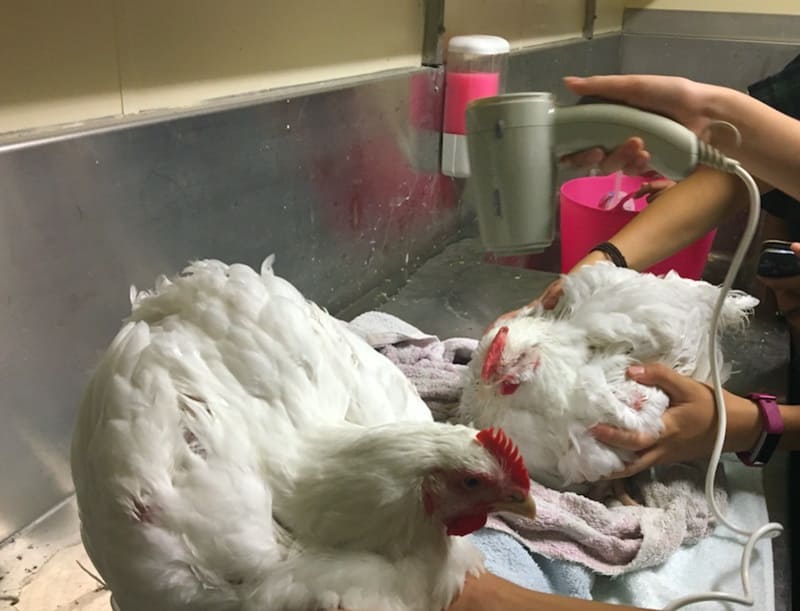
Monitoring for Complications
Watch for signs of respiratory distress, which can occur if the chicken inhaled water. Symptoms include:
- Labored breathing or wheezing
- Discharge from the nostrils or beak
- Unusual head positioning
- Continued lethargy after warming
If you notice any of these signs, contact an avian veterinarian immediately. Chickens can develop pneumonia from water inhalation, which requires professional treatment.
Recovery Expectations
A healthy chicken should return to normal behavior within an hour of proper drying and warming. Expect some temporary lethargy as their system recovers from the stress. Provide easily digestible food like scrambled eggs or wet mash to help restore their energy.
Some chickens may be more cautious around water following a traumatic experience, which is actually a positive adaptive response.
Breed-Specific Swimming Considerations
Not all chickens face equal risks in water. Understanding your specific breeds can help you make informed decisions about water safety.
Natural Swimmers (Relatively Speaking)
Lighter breeds with tight feathering tend to fare better in water emergencies. Rhode Island Reds, Leghorns, and other production breeds often have the body structure and temperament that makes them more likely to survive accidental water exposure.
Game breeds, despite their sometimes aggressive nature, often possess the calm confidence that serves them well in unusual situations, including unexpected water encounters.
High-Risk Breeds
Heavy breeds like Brahmas, Cochins, and Orpingtons face greater drowning risks due to their substantial body weight and slower movements. Their bulk works against them in water, making it harder to stay afloat once their feathers become saturated.
Silkies deserve special mention as perhaps the most water-vulnerable breed. Their unique, down-like feathers provide no water resistance whatsoever. A Silkie in water has literally seconds before sinking, making water safety absolutely critical for owners of this breed.
Breeds with excessive feathering, including those with feathered feet, face additional challenges as their plumage becomes waterlogged more quickly than streamlined breeds.
Explore Top Egg-Laying Chicken Breeds for Your Backyard Flock
Seasonal Water Safety Considerations
Water risks change with the seasons, requiring different precautions throughout the year.
Summer Vigilance
Hot weather increases both the temptation to use water for cooling and the risks associated with it. Chickens suffering from heat stress may make poor decisions about entering water sources they’d normally avoid.
Monitor temporary water sources created by summer storms, as chickens might seek these out for cooling without understanding the drowning risks.
Winter Hazards
Icy conditions create slip hazards that can send chickens tumbling into water unexpectedly. Even normally safe, shallow water sources become dangerous when ice formations create unstable edges.
Frozen water containers that partially thaw can create unexpected deep spots that catch chickens off guard.
Spring and Fall Transitions
Seasonal rains create temporary pools and puddles that may seem harmless but can pose risks, especially for smaller or younger birds. These temporary water sources often lack the natural exit points that established ponds or streams provide.
Making Water-Smart Decisions for Your Flock
The key to chicken water safety lies in understanding that your birds don’t need swimming opportunities to live happy, healthy lives. Focus on providing what they actually need: fresh drinking water, appropriate cooling options during hot weather, and safety from water-related accidents.
Consider your individual chickens’ personalities when making decisions about water access. That bold, adventurous hen who leads the flock might handle shallow wading better than her nervous, flighty companions. However, even confident chickens benefit from careful supervision around any water deeper than their legs.
Remember that chickens have survived and thrived for thousands of years without swimming pools or extensive water access. Their natural behaviors – dust bathing, foraging, and social interactions – provide everything they need for physical and mental well-being.
The Bottom Line: Respecting Chicken Nature
After examining the evidence from multiple angles, the conclusion is clear: while chickens possess basic swimming capabilities, water activities carry significant risks that generally outweigh any potential benefits.
Your chickens are perfectly designed for the lives they’re meant to live – scratching for treats, taking luxurious dust baths, and maintaining their position in the pecking order. They don’t need swimming lessons or pool time to be fulfilled.
The best chicken care comes from understanding and supporting their natural behaviors rather than imposing activities that make us feel good but may not serve their best interests. Keep your chickens safe, dry, and happy doing what chickens do best – being wonderfully, authentically chicken.
When summer heat threatens your flock’s comfort, focus on proven cooling methods like shade, ventilation, and appropriate water sources for drinking and wading. Your chickens will thank you for keeping their feet firmly planted on the solid ground where they belong, while still ensuring they stay cool and comfortable through even the hottest weather.
Trust in their natural instincts, provide appropriate environmental management, and enjoy watching your flock thrive in the safe, secure environment you’ve created for them.
